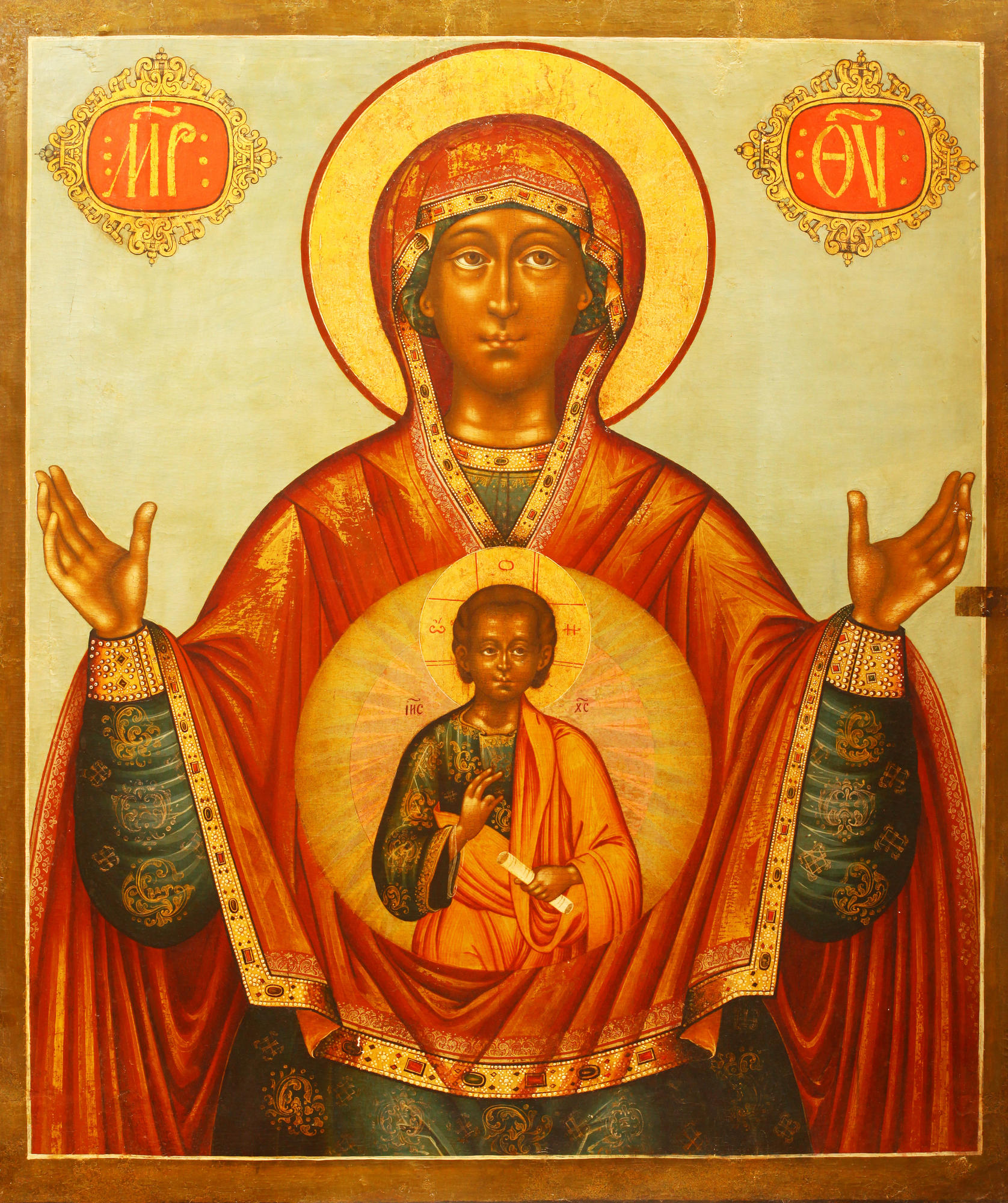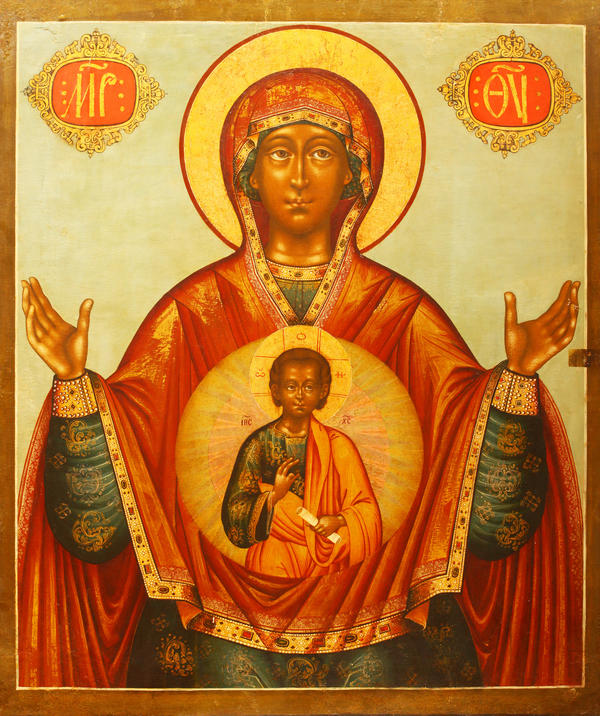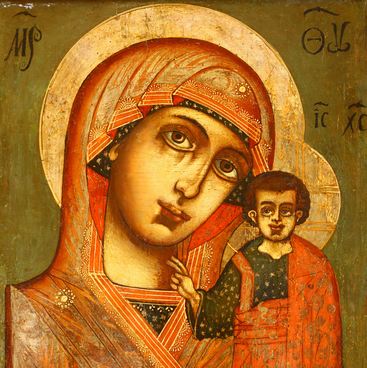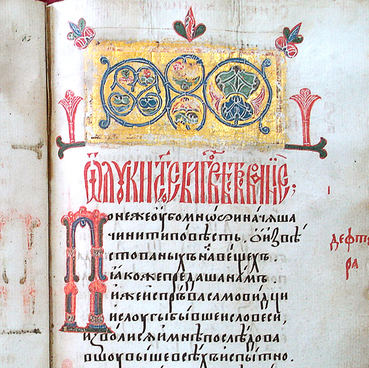On the icon, the Virgin Mary is depicted in the Orans position with her hands raised and outstretched in prayer. The image of the Child Jesus is depicted within a round aureole upon her breast. In 1938, the icon was delivered to the Museum of Local History from the church of Saint John the Apostle of the city of Saransk.
In the 9th-12th centuries, the Middle Byzantine period, the icon was aimed at glorifying the Virgin Mary and affirming the Incarnation of God the Son. This iconography must have appeared in the Byzantine Empire before the veneration of Orthodox icons. Some facts can prove that this icon painting type was revived in Constantinople approximately in mid 11th century.
The peculiarity of the icon painting type is the combination of two images of the Virgin Mary venerated in Church of St. Mary of Blachernae. The first image was described in the Book of Ceremonies of Constantine VII Porphyrogennetos in the 10th century, this was a marble sculpture of the Virgin Mary with raised hands from which holy water was flowing. The second image is the figure of the Virgin Mary holding an image of Christ on a round shield or plate. This image was concealed under a layer of mortar during the iconoclastic period and it was discovered in 1030-1031.
The iconography in accordance with the Byzantine tradition was sometimes called the Theotokos of Blachernae and had many interpretations. The raised hands of the Virgin Mary and her wide-open maphorion, a woman’s outwear covering the body from head to toe, was treated as the symbol of protection of all Christian world. This idea was also conveyed in the altar mosaic of Saint Sophia’s Cathedral in Kiev and Russian iconography of the Intercession of the Theotokos. The second main idea of the icon, the Incarnation of the Son of God, was associated with the Divine Light brought to the world.
The icon highlights the idea of the Divine Light conveyed through multicolor rays originating from the image of the Divine Child depicted within an aureole and the head of the Virgin Mary. A very interesting detail is that the halo of Jesus Christ goes beyond the aureole. The borders of the circle was covered with oil vanish several times to bring more volume to pink and green radiance around the Saviour. Rays are painted within the aureole, gold rays originate from the center while silver rays go to the Divine Child.
During post-Byzantine period approximately from the 15th century the image of the Virgin Mary with the image of the Incarnated Christ (both with the aureole and without) was called Our Lady of the Incarnation or Our Lady of the Sign in the Russian icon painting. Initially, the title Our Lady of the Sign was more often used for Novgorod icons.
It is believed that the word sign was a reference to the prophecy of Isaiah and miracles performed with the help of Novgorod Our Lady of the Sign in the 12th century. When, during feuds between princes, Russian princes besieged Novgorod in 1170, the citizens brought the icon of the Most Holy Mother of God on the Kremlin walls. One of the besiegers’ arrows hit the wonderworking icon and tears streamed down from the eyes of the God’s Mother. According to one of the legends, darkness spread over the city and the besiegers, stricken with fear, left the Novgorod lands.
In the 9th-12th centuries, the Middle Byzantine period, the icon was aimed at glorifying the Virgin Mary and affirming the Incarnation of God the Son. This iconography must have appeared in the Byzantine Empire before the veneration of Orthodox icons. Some facts can prove that this icon painting type was revived in Constantinople approximately in mid 11th century.
The peculiarity of the icon painting type is the combination of two images of the Virgin Mary venerated in Church of St. Mary of Blachernae. The first image was described in the Book of Ceremonies of Constantine VII Porphyrogennetos in the 10th century, this was a marble sculpture of the Virgin Mary with raised hands from which holy water was flowing. The second image is the figure of the Virgin Mary holding an image of Christ on a round shield or plate. This image was concealed under a layer of mortar during the iconoclastic period and it was discovered in 1030-1031.
The iconography in accordance with the Byzantine tradition was sometimes called the Theotokos of Blachernae and had many interpretations. The raised hands of the Virgin Mary and her wide-open maphorion, a woman’s outwear covering the body from head to toe, was treated as the symbol of protection of all Christian world. This idea was also conveyed in the altar mosaic of Saint Sophia’s Cathedral in Kiev and Russian iconography of the Intercession of the Theotokos. The second main idea of the icon, the Incarnation of the Son of God, was associated with the Divine Light brought to the world.
The icon highlights the idea of the Divine Light conveyed through multicolor rays originating from the image of the Divine Child depicted within an aureole and the head of the Virgin Mary. A very interesting detail is that the halo of Jesus Christ goes beyond the aureole. The borders of the circle was covered with oil vanish several times to bring more volume to pink and green radiance around the Saviour. Rays are painted within the aureole, gold rays originate from the center while silver rays go to the Divine Child.
During post-Byzantine period approximately from the 15th century the image of the Virgin Mary with the image of the Incarnated Christ (both with the aureole and without) was called Our Lady of the Incarnation or Our Lady of the Sign in the Russian icon painting. Initially, the title Our Lady of the Sign was more often used for Novgorod icons.
It is believed that the word sign was a reference to the prophecy of Isaiah and miracles performed with the help of Novgorod Our Lady of the Sign in the 12th century. When, during feuds between princes, Russian princes besieged Novgorod in 1170, the citizens brought the icon of the Most Holy Mother of God on the Kremlin walls. One of the besiegers’ arrows hit the wonderworking icon and tears streamed down from the eyes of the God’s Mother. According to one of the legends, darkness spread over the city and the besiegers, stricken with fear, left the Novgorod lands.



